Comparing group assignment PDF
VerifiedAdded on 2021/10/07
|10
|2813
|110
AI Summary
Contribute Materials
Your contribution can guide someone’s learning journey. Share your
documents today.
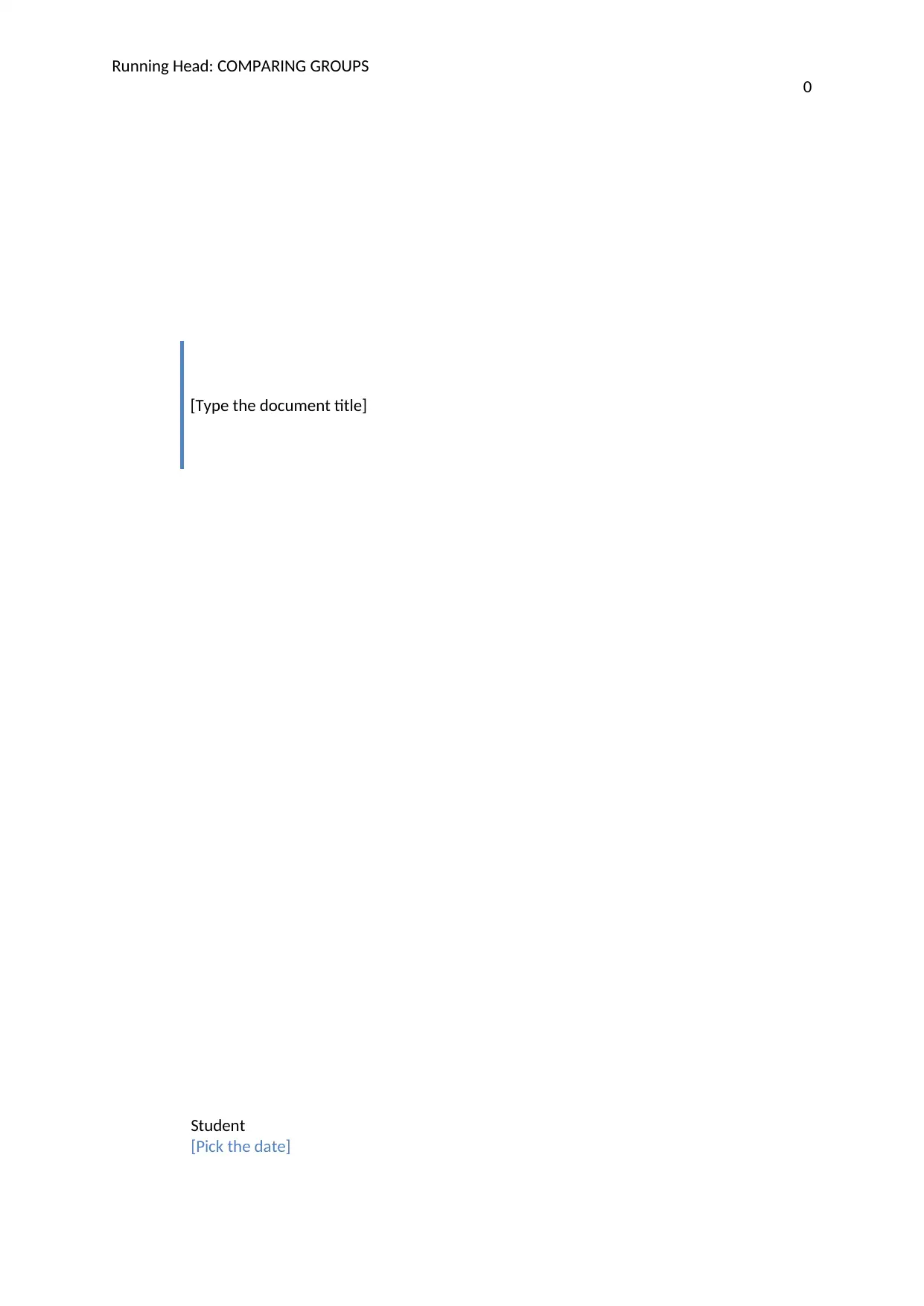
Running Head: COMPARING GROUPS
0
[Type the document title]
Student
[Pick the date]
0
[Type the document title]
Student
[Pick the date]
Secure Best Marks with AI Grader
Need help grading? Try our AI Grader for instant feedback on your assignments.
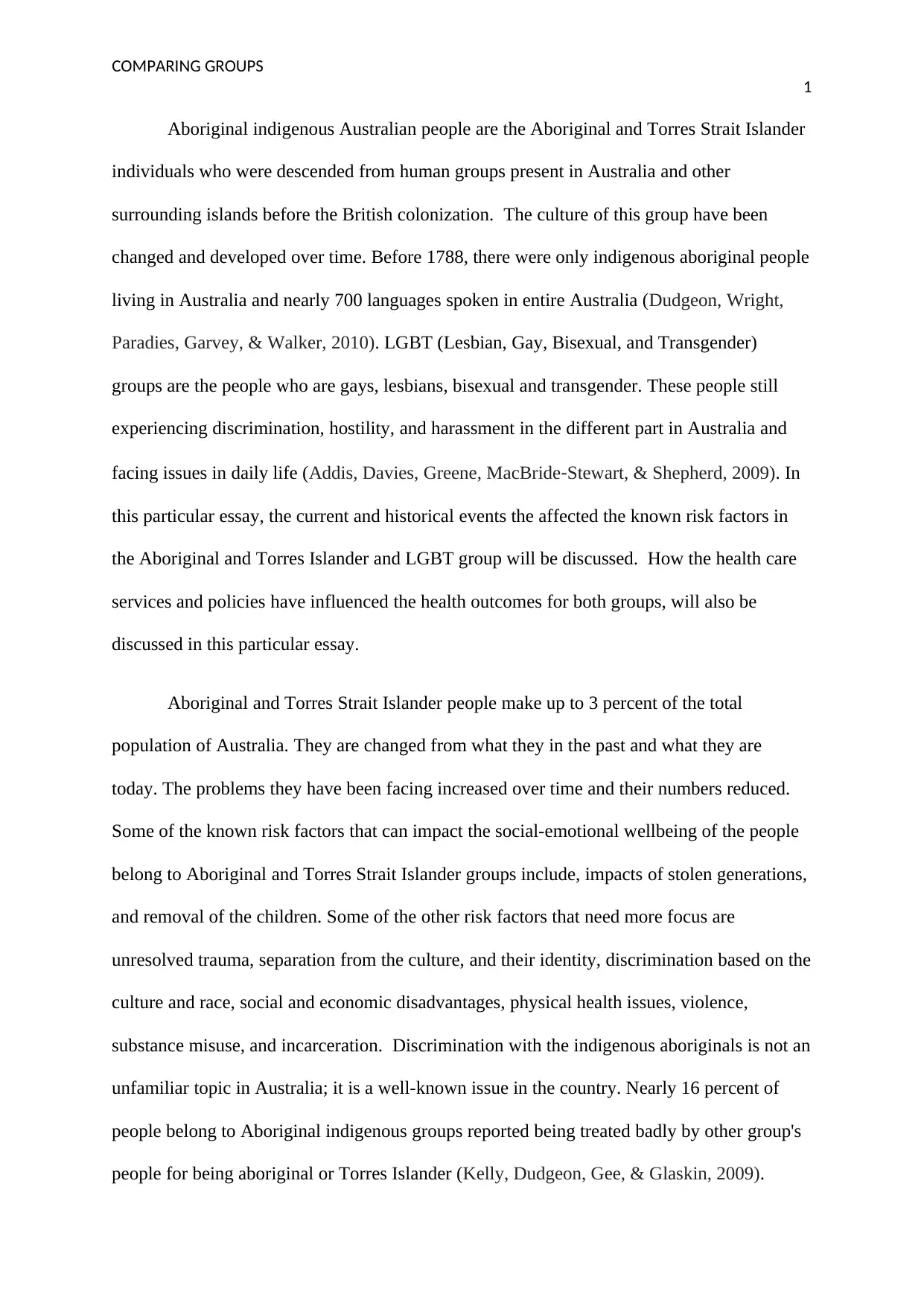
COMPARING GROUPS
1
Aboriginal indigenous Australian people are the Aboriginal and Torres Strait Islander
individuals who were descended from human groups present in Australia and other
surrounding islands before the British colonization. The culture of this group have been
changed and developed over time. Before 1788, there were only indigenous aboriginal people
living in Australia and nearly 700 languages spoken in entire Australia (Dudgeon, Wright,
Paradies, Garvey, & Walker, 2010). LGBT (Lesbian, Gay, Bisexual, and Transgender)
groups are the people who are gays, lesbians, bisexual and transgender. These people still
experiencing discrimination, hostility, and harassment in the different part in Australia and
facing issues in daily life (Addis, Davies, Greene, MacBride‐Stewart, & Shepherd, 2009). In
this particular essay, the current and historical events the affected the known risk factors in
the Aboriginal and Torres Islander and LGBT group will be discussed. How the health care
services and policies have influenced the health outcomes for both groups, will also be
discussed in this particular essay.
Aboriginal and Torres Strait Islander people make up to 3 percent of the total
population of Australia. They are changed from what they in the past and what they are
today. The problems they have been facing increased over time and their numbers reduced.
Some of the known risk factors that can impact the social-emotional wellbeing of the people
belong to Aboriginal and Torres Strait Islander groups include, impacts of stolen generations,
and removal of the children. Some of the other risk factors that need more focus are
unresolved trauma, separation from the culture, and their identity, discrimination based on the
culture and race, social and economic disadvantages, physical health issues, violence,
substance misuse, and incarceration. Discrimination with the indigenous aboriginals is not an
unfamiliar topic in Australia; it is a well-known issue in the country. Nearly 16 percent of
people belong to Aboriginal indigenous groups reported being treated badly by other group's
people for being aboriginal or Torres Islander (Kelly, Dudgeon, Gee, & Glaskin, 2009).
1
Aboriginal indigenous Australian people are the Aboriginal and Torres Strait Islander
individuals who were descended from human groups present in Australia and other
surrounding islands before the British colonization. The culture of this group have been
changed and developed over time. Before 1788, there were only indigenous aboriginal people
living in Australia and nearly 700 languages spoken in entire Australia (Dudgeon, Wright,
Paradies, Garvey, & Walker, 2010). LGBT (Lesbian, Gay, Bisexual, and Transgender)
groups are the people who are gays, lesbians, bisexual and transgender. These people still
experiencing discrimination, hostility, and harassment in the different part in Australia and
facing issues in daily life (Addis, Davies, Greene, MacBride‐Stewart, & Shepherd, 2009). In
this particular essay, the current and historical events the affected the known risk factors in
the Aboriginal and Torres Islander and LGBT group will be discussed. How the health care
services and policies have influenced the health outcomes for both groups, will also be
discussed in this particular essay.
Aboriginal and Torres Strait Islander people make up to 3 percent of the total
population of Australia. They are changed from what they in the past and what they are
today. The problems they have been facing increased over time and their numbers reduced.
Some of the known risk factors that can impact the social-emotional wellbeing of the people
belong to Aboriginal and Torres Strait Islander groups include, impacts of stolen generations,
and removal of the children. Some of the other risk factors that need more focus are
unresolved trauma, separation from the culture, and their identity, discrimination based on the
culture and race, social and economic disadvantages, physical health issues, violence,
substance misuse, and incarceration. Discrimination with the indigenous aboriginals is not an
unfamiliar topic in Australia; it is a well-known issue in the country. Nearly 16 percent of
people belong to Aboriginal indigenous groups reported being treated badly by other group's
people for being aboriginal or Torres Islander (Kelly, Dudgeon, Gee, & Glaskin, 2009).
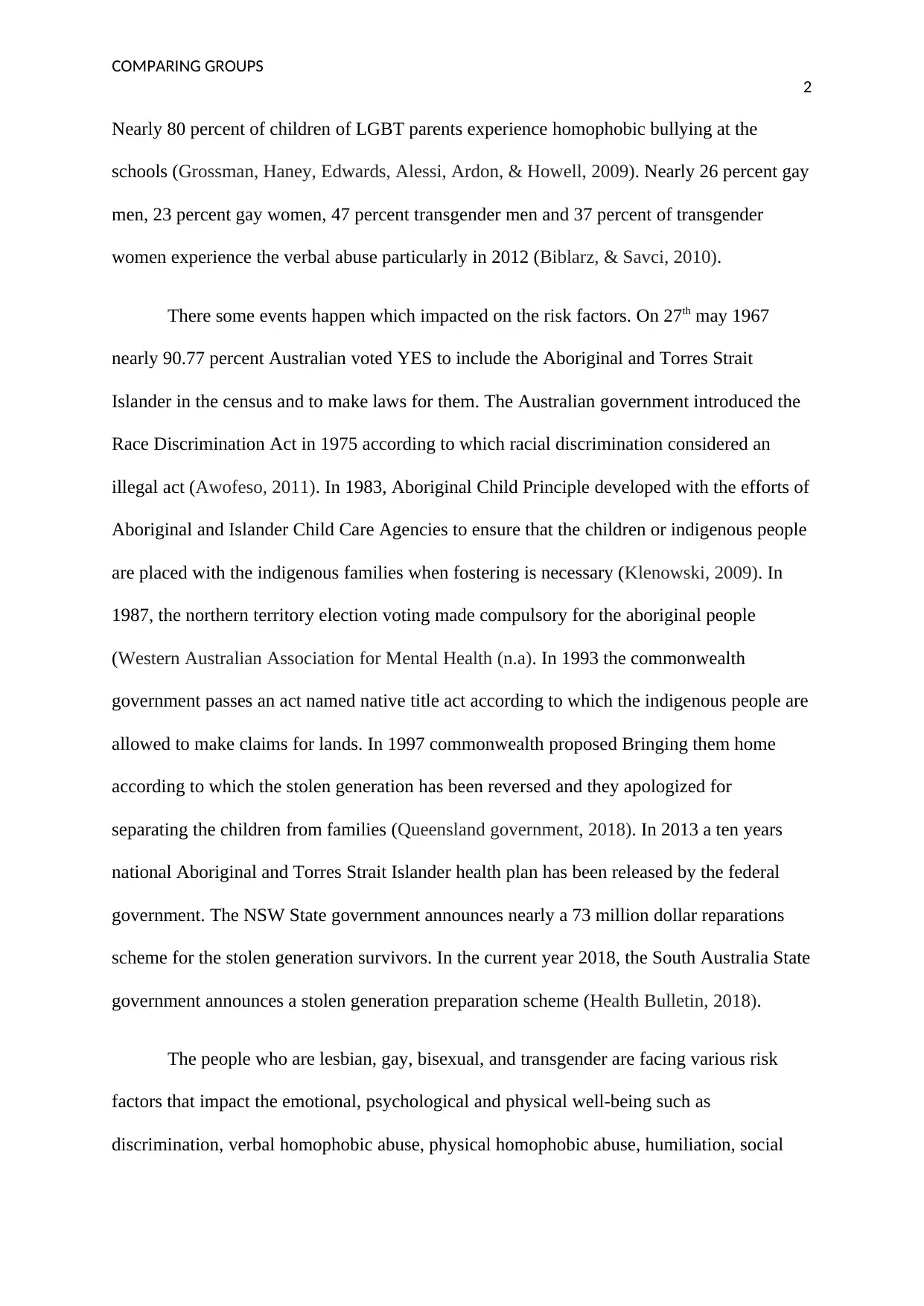
COMPARING GROUPS
2
Nearly 80 percent of children of LGBT parents experience homophobic bullying at the
schools (Grossman, Haney, Edwards, Alessi, Ardon, & Howell, 2009). Nearly 26 percent gay
men, 23 percent gay women, 47 percent transgender men and 37 percent of transgender
women experience the verbal abuse particularly in 2012 (Biblarz, & Savci, 2010).
There some events happen which impacted on the risk factors. On 27th may 1967
nearly 90.77 percent Australian voted YES to include the Aboriginal and Torres Strait
Islander in the census and to make laws for them. The Australian government introduced the
Race Discrimination Act in 1975 according to which racial discrimination considered an
illegal act (Awofeso, 2011). In 1983, Aboriginal Child Principle developed with the efforts of
Aboriginal and Islander Child Care Agencies to ensure that the children or indigenous people
are placed with the indigenous families when fostering is necessary (Klenowski, 2009). In
1987, the northern territory election voting made compulsory for the aboriginal people
(Western Australian Association for Mental Health (n.a). In 1993 the commonwealth
government passes an act named native title act according to which the indigenous people are
allowed to make claims for lands. In 1997 commonwealth proposed Bringing them home
according to which the stolen generation has been reversed and they apologized for
separating the children from families (Queensland government, 2018). In 2013 a ten years
national Aboriginal and Torres Strait Islander health plan has been released by the federal
government. The NSW State government announces nearly a 73 million dollar reparations
scheme for the stolen generation survivors. In the current year 2018, the South Australia State
government announces a stolen generation preparation scheme (Health Bulletin, 2018).
The people who are lesbian, gay, bisexual, and transgender are facing various risk
factors that impact the emotional, psychological and physical well-being such as
discrimination, verbal homophobic abuse, physical homophobic abuse, humiliation, social
2
Nearly 80 percent of children of LGBT parents experience homophobic bullying at the
schools (Grossman, Haney, Edwards, Alessi, Ardon, & Howell, 2009). Nearly 26 percent gay
men, 23 percent gay women, 47 percent transgender men and 37 percent of transgender
women experience the verbal abuse particularly in 2012 (Biblarz, & Savci, 2010).
There some events happen which impacted on the risk factors. On 27th may 1967
nearly 90.77 percent Australian voted YES to include the Aboriginal and Torres Strait
Islander in the census and to make laws for them. The Australian government introduced the
Race Discrimination Act in 1975 according to which racial discrimination considered an
illegal act (Awofeso, 2011). In 1983, Aboriginal Child Principle developed with the efforts of
Aboriginal and Islander Child Care Agencies to ensure that the children or indigenous people
are placed with the indigenous families when fostering is necessary (Klenowski, 2009). In
1987, the northern territory election voting made compulsory for the aboriginal people
(Western Australian Association for Mental Health (n.a). In 1993 the commonwealth
government passes an act named native title act according to which the indigenous people are
allowed to make claims for lands. In 1997 commonwealth proposed Bringing them home
according to which the stolen generation has been reversed and they apologized for
separating the children from families (Queensland government, 2018). In 2013 a ten years
national Aboriginal and Torres Strait Islander health plan has been released by the federal
government. The NSW State government announces nearly a 73 million dollar reparations
scheme for the stolen generation survivors. In the current year 2018, the South Australia State
government announces a stolen generation preparation scheme (Health Bulletin, 2018).
The people who are lesbian, gay, bisexual, and transgender are facing various risk
factors that impact the emotional, psychological and physical well-being such as
discrimination, verbal homophobic abuse, physical homophobic abuse, humiliation, social
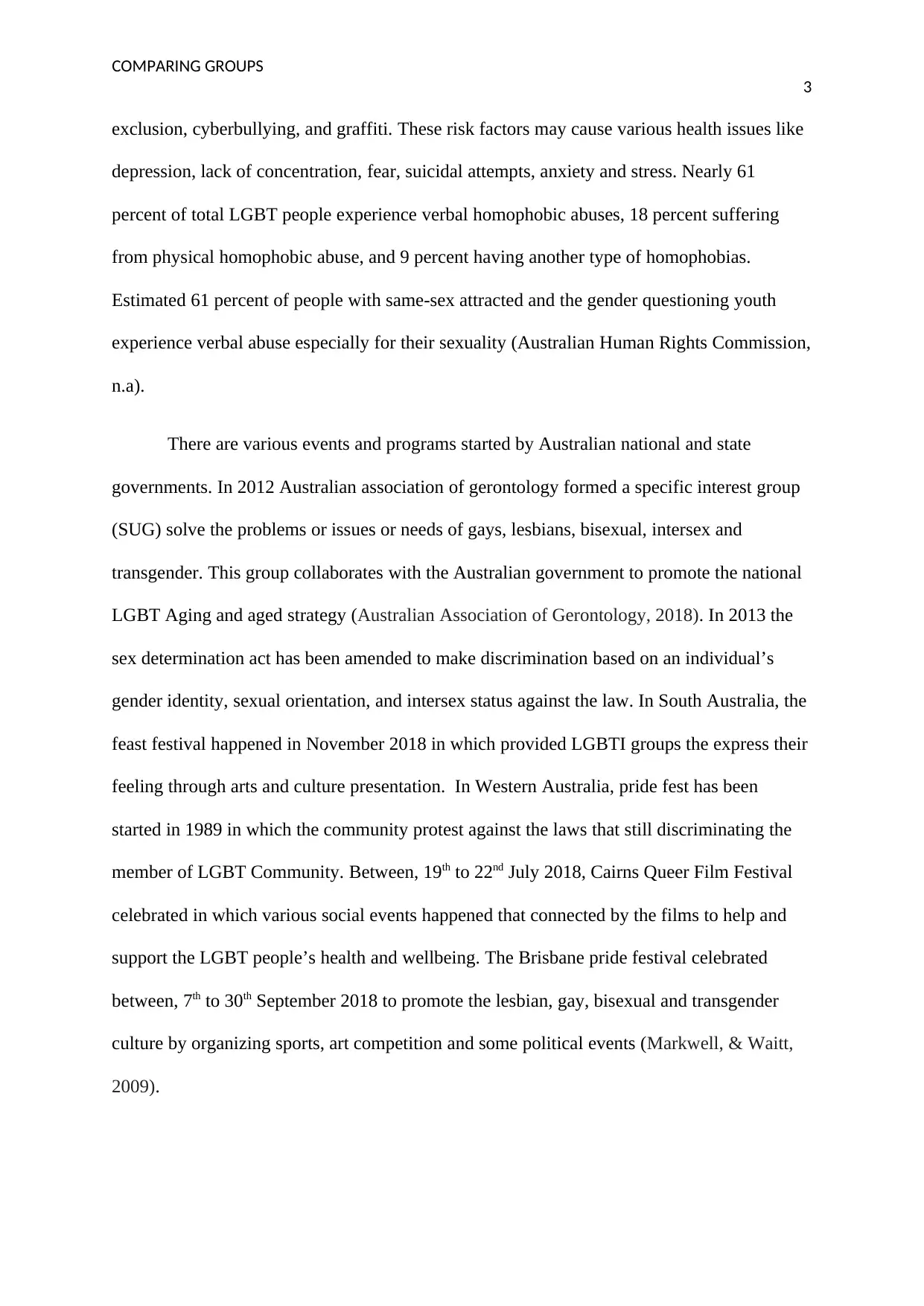
COMPARING GROUPS
3
exclusion, cyberbullying, and graffiti. These risk factors may cause various health issues like
depression, lack of concentration, fear, suicidal attempts, anxiety and stress. Nearly 61
percent of total LGBT people experience verbal homophobic abuses, 18 percent suffering
from physical homophobic abuse, and 9 percent having another type of homophobias.
Estimated 61 percent of people with same-sex attracted and the gender questioning youth
experience verbal abuse especially for their sexuality (Australian Human Rights Commission,
n.a).
There are various events and programs started by Australian national and state
governments. In 2012 Australian association of gerontology formed a specific interest group
(SUG) solve the problems or issues or needs of gays, lesbians, bisexual, intersex and
transgender. This group collaborates with the Australian government to promote the national
LGBT Aging and aged strategy (Australian Association of Gerontology, 2018). In 2013 the
sex determination act has been amended to make discrimination based on an individual’s
gender identity, sexual orientation, and intersex status against the law. In South Australia, the
feast festival happened in November 2018 in which provided LGBTI groups the express their
feeling through arts and culture presentation. In Western Australia, pride fest has been
started in 1989 in which the community protest against the laws that still discriminating the
member of LGBT Community. Between, 19th to 22nd July 2018, Cairns Queer Film Festival
celebrated in which various social events happened that connected by the films to help and
support the LGBT people’s health and wellbeing. The Brisbane pride festival celebrated
between, 7th to 30th September 2018 to promote the lesbian, gay, bisexual and transgender
culture by organizing sports, art competition and some political events (Markwell, & Waitt,
2009).
3
exclusion, cyberbullying, and graffiti. These risk factors may cause various health issues like
depression, lack of concentration, fear, suicidal attempts, anxiety and stress. Nearly 61
percent of total LGBT people experience verbal homophobic abuses, 18 percent suffering
from physical homophobic abuse, and 9 percent having another type of homophobias.
Estimated 61 percent of people with same-sex attracted and the gender questioning youth
experience verbal abuse especially for their sexuality (Australian Human Rights Commission,
n.a).
There are various events and programs started by Australian national and state
governments. In 2012 Australian association of gerontology formed a specific interest group
(SUG) solve the problems or issues or needs of gays, lesbians, bisexual, intersex and
transgender. This group collaborates with the Australian government to promote the national
LGBT Aging and aged strategy (Australian Association of Gerontology, 2018). In 2013 the
sex determination act has been amended to make discrimination based on an individual’s
gender identity, sexual orientation, and intersex status against the law. In South Australia, the
feast festival happened in November 2018 in which provided LGBTI groups the express their
feeling through arts and culture presentation. In Western Australia, pride fest has been
started in 1989 in which the community protest against the laws that still discriminating the
member of LGBT Community. Between, 19th to 22nd July 2018, Cairns Queer Film Festival
celebrated in which various social events happened that connected by the films to help and
support the LGBT people’s health and wellbeing. The Brisbane pride festival celebrated
between, 7th to 30th September 2018 to promote the lesbian, gay, bisexual and transgender
culture by organizing sports, art competition and some political events (Markwell, & Waitt,
2009).
Secure Best Marks with AI Grader
Need help grading? Try our AI Grader for instant feedback on your assignments.
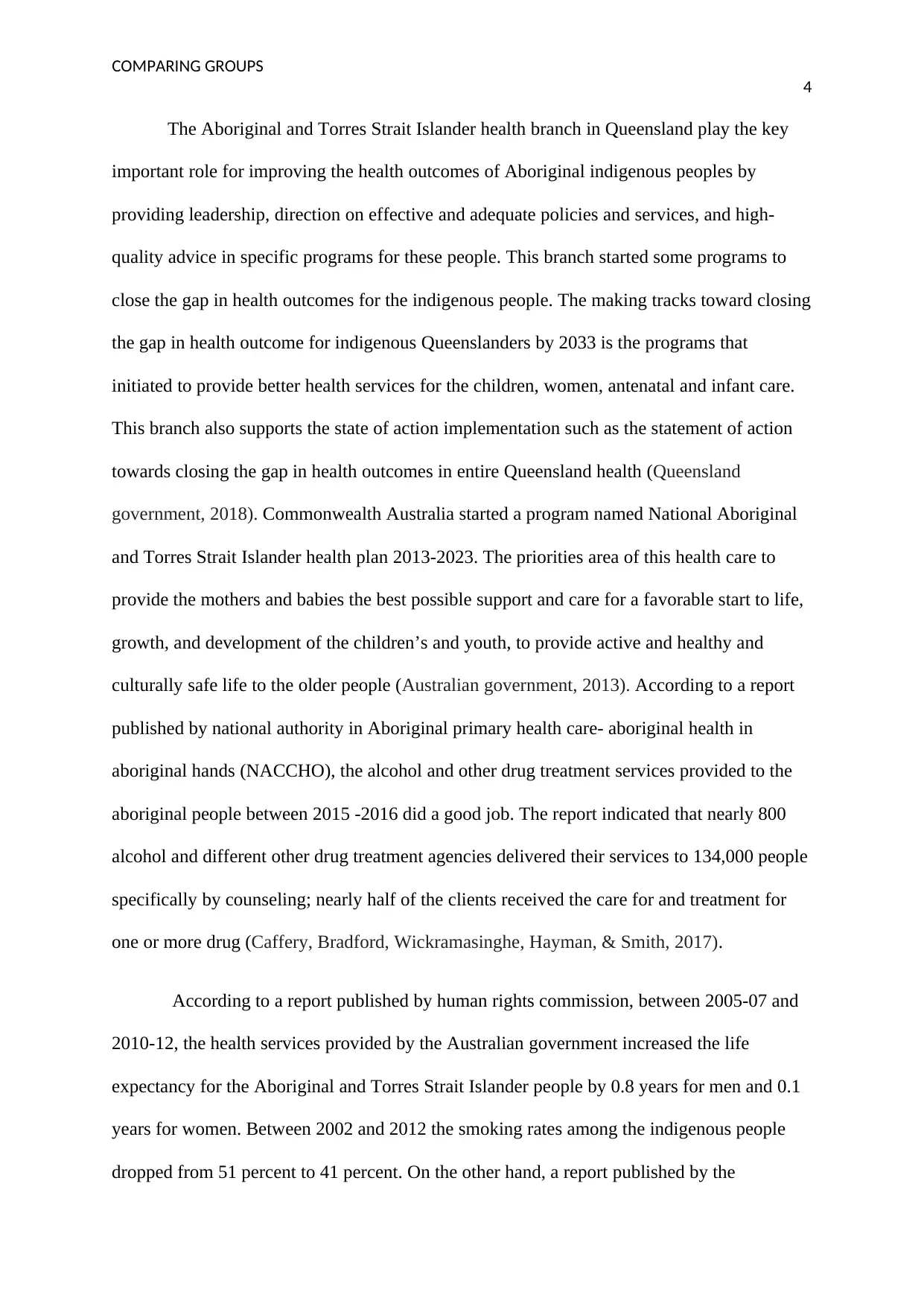
COMPARING GROUPS
4
The Aboriginal and Torres Strait Islander health branch in Queensland play the key
important role for improving the health outcomes of Aboriginal indigenous peoples by
providing leadership, direction on effective and adequate policies and services, and high-
quality advice in specific programs for these people. This branch started some programs to
close the gap in health outcomes for the indigenous people. The making tracks toward closing
the gap in health outcome for indigenous Queenslanders by 2033 is the programs that
initiated to provide better health services for the children, women, antenatal and infant care.
This branch also supports the state of action implementation such as the statement of action
towards closing the gap in health outcomes in entire Queensland health (Queensland
government, 2018). Commonwealth Australia started a program named National Aboriginal
and Torres Strait Islander health plan 2013-2023. The priorities area of this health care to
provide the mothers and babies the best possible support and care for a favorable start to life,
growth, and development of the children’s and youth, to provide active and healthy and
culturally safe life to the older people (Australian government, 2013). According to a report
published by national authority in Aboriginal primary health care- aboriginal health in
aboriginal hands (NACCHO), the alcohol and other drug treatment services provided to the
aboriginal people between 2015 -2016 did a good job. The report indicated that nearly 800
alcohol and different other drug treatment agencies delivered their services to 134,000 people
specifically by counseling; nearly half of the clients received the care for and treatment for
one or more drug (Caffery, Bradford, Wickramasinghe, Hayman, & Smith, 2017).
According to a report published by human rights commission, between 2005-07 and
2010-12, the health services provided by the Australian government increased the life
expectancy for the Aboriginal and Torres Strait Islander people by 0.8 years for men and 0.1
years for women. Between 2002 and 2012 the smoking rates among the indigenous people
dropped from 51 percent to 41 percent. On the other hand, a report published by the
4
The Aboriginal and Torres Strait Islander health branch in Queensland play the key
important role for improving the health outcomes of Aboriginal indigenous peoples by
providing leadership, direction on effective and adequate policies and services, and high-
quality advice in specific programs for these people. This branch started some programs to
close the gap in health outcomes for the indigenous people. The making tracks toward closing
the gap in health outcome for indigenous Queenslanders by 2033 is the programs that
initiated to provide better health services for the children, women, antenatal and infant care.
This branch also supports the state of action implementation such as the statement of action
towards closing the gap in health outcomes in entire Queensland health (Queensland
government, 2018). Commonwealth Australia started a program named National Aboriginal
and Torres Strait Islander health plan 2013-2023. The priorities area of this health care to
provide the mothers and babies the best possible support and care for a favorable start to life,
growth, and development of the children’s and youth, to provide active and healthy and
culturally safe life to the older people (Australian government, 2013). According to a report
published by national authority in Aboriginal primary health care- aboriginal health in
aboriginal hands (NACCHO), the alcohol and other drug treatment services provided to the
aboriginal people between 2015 -2016 did a good job. The report indicated that nearly 800
alcohol and different other drug treatment agencies delivered their services to 134,000 people
specifically by counseling; nearly half of the clients received the care for and treatment for
one or more drug (Caffery, Bradford, Wickramasinghe, Hayman, & Smith, 2017).
According to a report published by human rights commission, between 2005-07 and
2010-12, the health services provided by the Australian government increased the life
expectancy for the Aboriginal and Torres Strait Islander people by 0.8 years for men and 0.1
years for women. Between 2002 and 2012 the smoking rates among the indigenous people
dropped from 51 percent to 41 percent. On the other hand, a report published by the
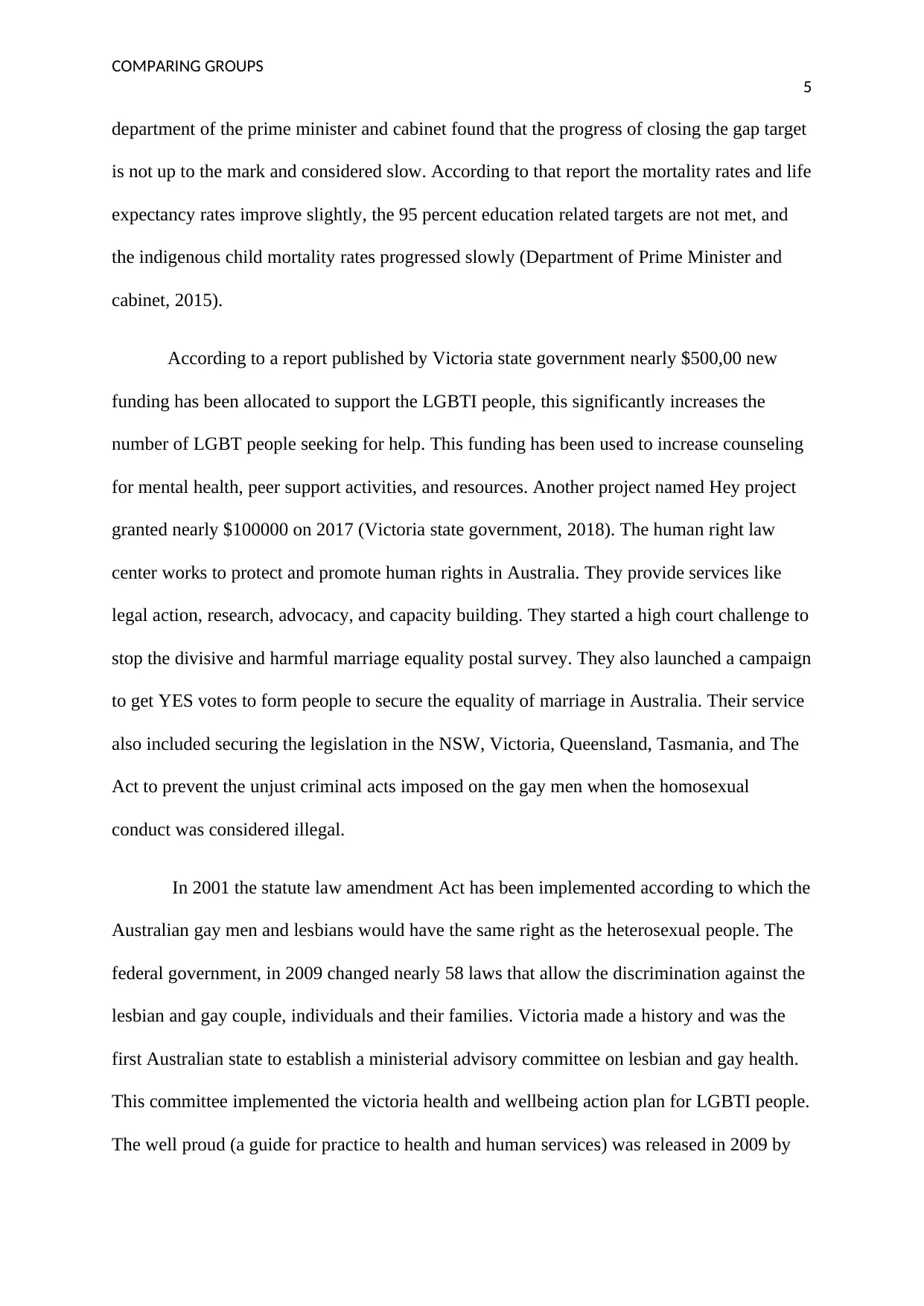
COMPARING GROUPS
5
department of the prime minister and cabinet found that the progress of closing the gap target
is not up to the mark and considered slow. According to that report the mortality rates and life
expectancy rates improve slightly, the 95 percent education related targets are not met, and
the indigenous child mortality rates progressed slowly (Department of Prime Minister and
cabinet, 2015).
According to a report published by Victoria state government nearly $500,00 new
funding has been allocated to support the LGBTI people, this significantly increases the
number of LGBT people seeking for help. This funding has been used to increase counseling
for mental health, peer support activities, and resources. Another project named Hey project
granted nearly $100000 on 2017 (Victoria state government, 2018). The human right law
center works to protect and promote human rights in Australia. They provide services like
legal action, research, advocacy, and capacity building. They started a high court challenge to
stop the divisive and harmful marriage equality postal survey. They also launched a campaign
to get YES votes to form people to secure the equality of marriage in Australia. Their service
also included securing the legislation in the NSW, Victoria, Queensland, Tasmania, and The
Act to prevent the unjust criminal acts imposed on the gay men when the homosexual
conduct was considered illegal.
In 2001 the statute law amendment Act has been implemented according to which the
Australian gay men and lesbians would have the same right as the heterosexual people. The
federal government, in 2009 changed nearly 58 laws that allow the discrimination against the
lesbian and gay couple, individuals and their families. Victoria made a history and was the
first Australian state to establish a ministerial advisory committee on lesbian and gay health.
This committee implemented the victoria health and wellbeing action plan for LGBTI people.
The well proud (a guide for practice to health and human services) was released in 2009 by
5
department of the prime minister and cabinet found that the progress of closing the gap target
is not up to the mark and considered slow. According to that report the mortality rates and life
expectancy rates improve slightly, the 95 percent education related targets are not met, and
the indigenous child mortality rates progressed slowly (Department of Prime Minister and
cabinet, 2015).
According to a report published by Victoria state government nearly $500,00 new
funding has been allocated to support the LGBTI people, this significantly increases the
number of LGBT people seeking for help. This funding has been used to increase counseling
for mental health, peer support activities, and resources. Another project named Hey project
granted nearly $100000 on 2017 (Victoria state government, 2018). The human right law
center works to protect and promote human rights in Australia. They provide services like
legal action, research, advocacy, and capacity building. They started a high court challenge to
stop the divisive and harmful marriage equality postal survey. They also launched a campaign
to get YES votes to form people to secure the equality of marriage in Australia. Their service
also included securing the legislation in the NSW, Victoria, Queensland, Tasmania, and The
Act to prevent the unjust criminal acts imposed on the gay men when the homosexual
conduct was considered illegal.
In 2001 the statute law amendment Act has been implemented according to which the
Australian gay men and lesbians would have the same right as the heterosexual people. The
federal government, in 2009 changed nearly 58 laws that allow the discrimination against the
lesbian and gay couple, individuals and their families. Victoria made a history and was the
first Australian state to establish a ministerial advisory committee on lesbian and gay health.
This committee implemented the victoria health and wellbeing action plan for LGBTI people.
The well proud (a guide for practice to health and human services) was released in 2009 by
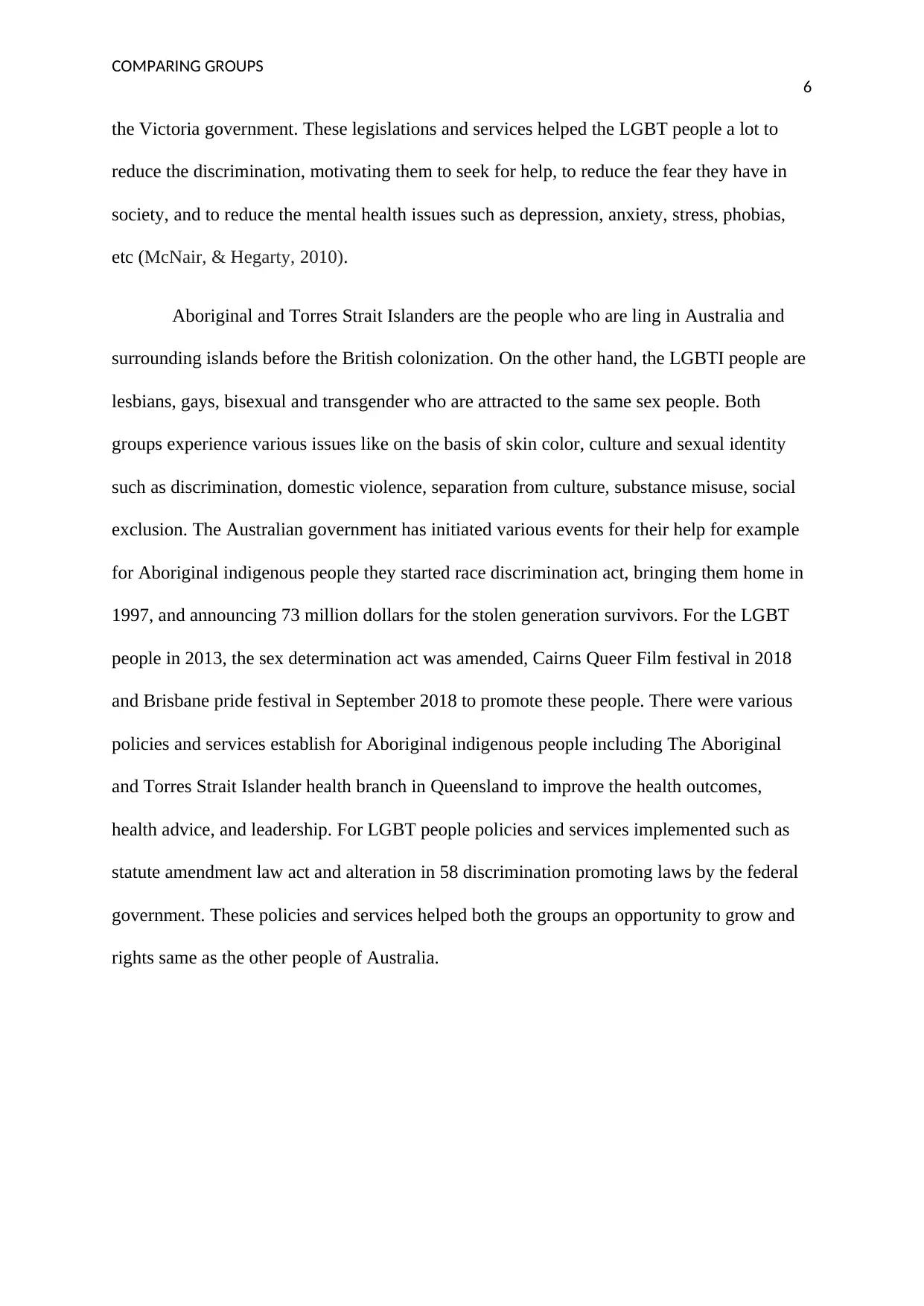
COMPARING GROUPS
6
the Victoria government. These legislations and services helped the LGBT people a lot to
reduce the discrimination, motivating them to seek for help, to reduce the fear they have in
society, and to reduce the mental health issues such as depression, anxiety, stress, phobias,
etc (McNair, & Hegarty, 2010).
Aboriginal and Torres Strait Islanders are the people who are ling in Australia and
surrounding islands before the British colonization. On the other hand, the LGBTI people are
lesbians, gays, bisexual and transgender who are attracted to the same sex people. Both
groups experience various issues like on the basis of skin color, culture and sexual identity
such as discrimination, domestic violence, separation from culture, substance misuse, social
exclusion. The Australian government has initiated various events for their help for example
for Aboriginal indigenous people they started race discrimination act, bringing them home in
1997, and announcing 73 million dollars for the stolen generation survivors. For the LGBT
people in 2013, the sex determination act was amended, Cairns Queer Film festival in 2018
and Brisbane pride festival in September 2018 to promote these people. There were various
policies and services establish for Aboriginal indigenous people including The Aboriginal
and Torres Strait Islander health branch in Queensland to improve the health outcomes,
health advice, and leadership. For LGBT people policies and services implemented such as
statute amendment law act and alteration in 58 discrimination promoting laws by the federal
government. These policies and services helped both the groups an opportunity to grow and
rights same as the other people of Australia.
6
the Victoria government. These legislations and services helped the LGBT people a lot to
reduce the discrimination, motivating them to seek for help, to reduce the fear they have in
society, and to reduce the mental health issues such as depression, anxiety, stress, phobias,
etc (McNair, & Hegarty, 2010).
Aboriginal and Torres Strait Islanders are the people who are ling in Australia and
surrounding islands before the British colonization. On the other hand, the LGBTI people are
lesbians, gays, bisexual and transgender who are attracted to the same sex people. Both
groups experience various issues like on the basis of skin color, culture and sexual identity
such as discrimination, domestic violence, separation from culture, substance misuse, social
exclusion. The Australian government has initiated various events for their help for example
for Aboriginal indigenous people they started race discrimination act, bringing them home in
1997, and announcing 73 million dollars for the stolen generation survivors. For the LGBT
people in 2013, the sex determination act was amended, Cairns Queer Film festival in 2018
and Brisbane pride festival in September 2018 to promote these people. There were various
policies and services establish for Aboriginal indigenous people including The Aboriginal
and Torres Strait Islander health branch in Queensland to improve the health outcomes,
health advice, and leadership. For LGBT people policies and services implemented such as
statute amendment law act and alteration in 58 discrimination promoting laws by the federal
government. These policies and services helped both the groups an opportunity to grow and
rights same as the other people of Australia.
Paraphrase This Document
Need a fresh take? Get an instant paraphrase of this document with our AI Paraphraser

COMPARING GROUPS
7
References
Addis, S., Davies, M., Greene, G., MacBride‐Stewart, S., & Shepherd, M. (2009). The health,
social care and housing needs of lesbian, gay, bisexual and transgender older people: a
review of the literature. Health & social care in the community, 17(6), 647-658.
Australian Association of Gerontology (2018). Policy, Research & international: lesbian,
gay, bisexual, transgender and intersex (LGBTI) etc. Retrieved from:
https://www.aag.asn.au/education/special-interest-groups/lesbian-gay-bisexual-
transgender-and-intersex-lgbti-sig
Australian government (2013). National Aboriginal and Torres Strait Islander Health Plan
2013-2023. Retrieved from:
https://www.health.gov.au/internet/main/publishing.nsf/content/B92E980680486C3B
CA257BF0001BAF01/$File/health-plan.pdf
Awofeso, N. (2011). Racism: a major impediment to optimal Indigenous health and health
care in Australia. Australian Indigenous Health Bulletin, 11(3), 1-8.
Biblarz, T. J., & Savci, E. (2010). Lesbian, gay, bisexual, and transgender families. Journal
of Marriage and Family, 72(3), 480-497.
Caffery, L. J., Bradford, N. K., Wickramasinghe, S. I., Hayman, N., & Smith, A. C. (2017).
Outcomes of using telehealth for the provision of health care to Aboriginal and Torres
Strait Islander people: a systematic review. Australian and New Zealand journal of
public health, 41(1), 48-53.
Department of Prime Minister and cabinet (2015). Closing the Gap 2015. Retrieved from:
https://www.pmc.gov.au/indigenous-affairs/closing-gap/closing-gap-2015
7
References
Addis, S., Davies, M., Greene, G., MacBride‐Stewart, S., & Shepherd, M. (2009). The health,
social care and housing needs of lesbian, gay, bisexual and transgender older people: a
review of the literature. Health & social care in the community, 17(6), 647-658.
Australian Association of Gerontology (2018). Policy, Research & international: lesbian,
gay, bisexual, transgender and intersex (LGBTI) etc. Retrieved from:
https://www.aag.asn.au/education/special-interest-groups/lesbian-gay-bisexual-
transgender-and-intersex-lgbti-sig
Australian government (2013). National Aboriginal and Torres Strait Islander Health Plan
2013-2023. Retrieved from:
https://www.health.gov.au/internet/main/publishing.nsf/content/B92E980680486C3B
CA257BF0001BAF01/$File/health-plan.pdf
Awofeso, N. (2011). Racism: a major impediment to optimal Indigenous health and health
care in Australia. Australian Indigenous Health Bulletin, 11(3), 1-8.
Biblarz, T. J., & Savci, E. (2010). Lesbian, gay, bisexual, and transgender families. Journal
of Marriage and Family, 72(3), 480-497.
Caffery, L. J., Bradford, N. K., Wickramasinghe, S. I., Hayman, N., & Smith, A. C. (2017).
Outcomes of using telehealth for the provision of health care to Aboriginal and Torres
Strait Islander people: a systematic review. Australian and New Zealand journal of
public health, 41(1), 48-53.
Department of Prime Minister and cabinet (2015). Closing the Gap 2015. Retrieved from:
https://www.pmc.gov.au/indigenous-affairs/closing-gap/closing-gap-2015
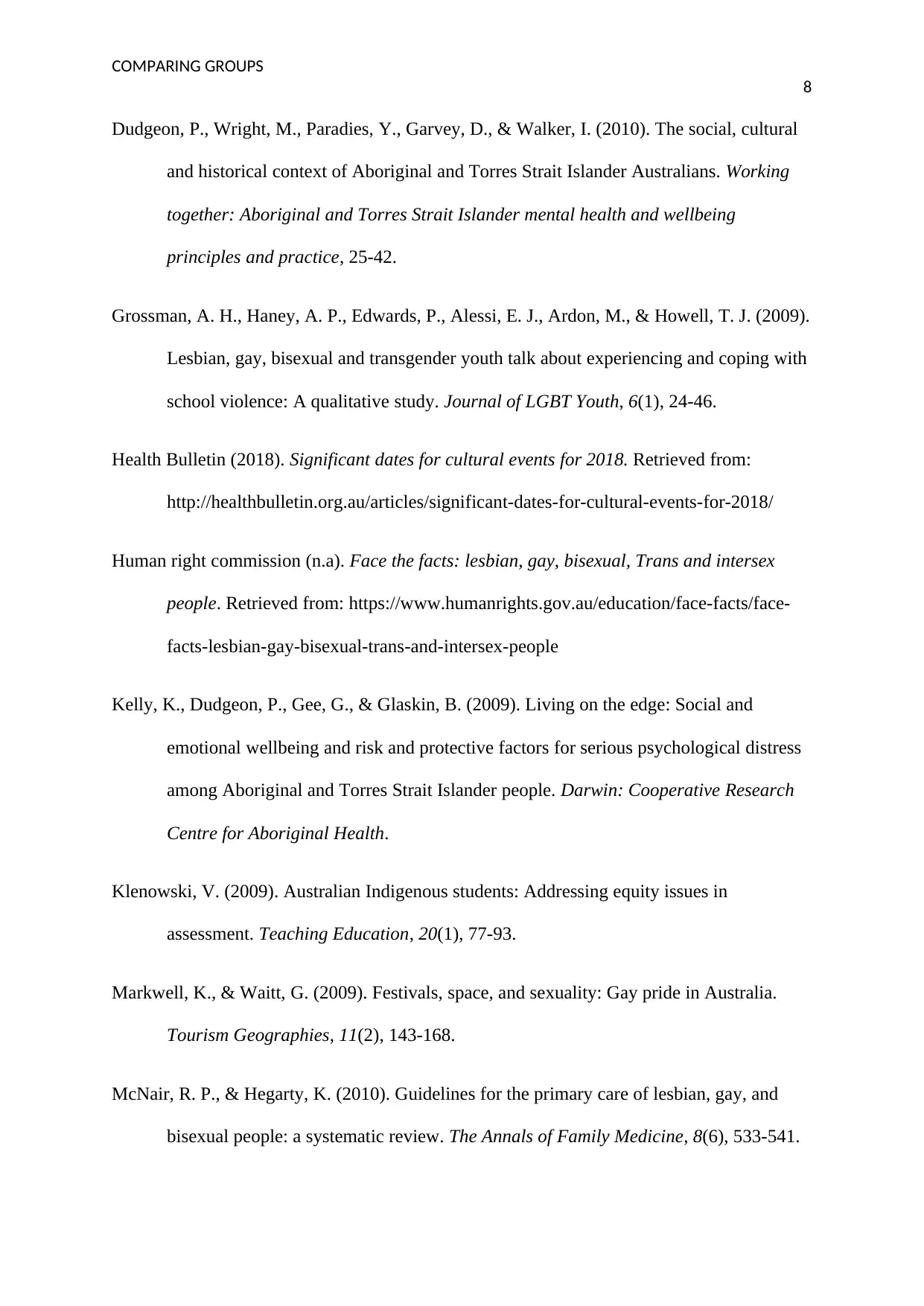
COMPARING GROUPS
8
Dudgeon, P., Wright, M., Paradies, Y., Garvey, D., & Walker, I. (2010). The social, cultural
and historical context of Aboriginal and Torres Strait Islander Australians. Working
together: Aboriginal and Torres Strait Islander mental health and wellbeing
principles and practice, 25-42.
Grossman, A. H., Haney, A. P., Edwards, P., Alessi, E. J., Ardon, M., & Howell, T. J. (2009).
Lesbian, gay, bisexual and transgender youth talk about experiencing and coping with
school violence: A qualitative study. Journal of LGBT Youth, 6(1), 24-46.
Health Bulletin (2018). Significant dates for cultural events for 2018. Retrieved from:
http://healthbulletin.org.au/articles/significant-dates-for-cultural-events-for-2018/
Human right commission (n.a). Face the facts: lesbian, gay, bisexual, Trans and intersex
people. Retrieved from: https://www.humanrights.gov.au/education/face-facts/face-
facts-lesbian-gay-bisexual-trans-and-intersex-people
Kelly, K., Dudgeon, P., Gee, G., & Glaskin, B. (2009). Living on the edge: Social and
emotional wellbeing and risk and protective factors for serious psychological distress
among Aboriginal and Torres Strait Islander people. Darwin: Cooperative Research
Centre for Aboriginal Health.
Klenowski, V. (2009). Australian Indigenous students: Addressing equity issues in
assessment. Teaching Education, 20(1), 77-93.
Markwell, K., & Waitt, G. (2009). Festivals, space, and sexuality: Gay pride in Australia.
Tourism Geographies, 11(2), 143-168.
McNair, R. P., & Hegarty, K. (2010). Guidelines for the primary care of lesbian, gay, and
bisexual people: a systematic review. The Annals of Family Medicine, 8(6), 533-541.
8
Dudgeon, P., Wright, M., Paradies, Y., Garvey, D., & Walker, I. (2010). The social, cultural
and historical context of Aboriginal and Torres Strait Islander Australians. Working
together: Aboriginal and Torres Strait Islander mental health and wellbeing
principles and practice, 25-42.
Grossman, A. H., Haney, A. P., Edwards, P., Alessi, E. J., Ardon, M., & Howell, T. J. (2009).
Lesbian, gay, bisexual and transgender youth talk about experiencing and coping with
school violence: A qualitative study. Journal of LGBT Youth, 6(1), 24-46.
Health Bulletin (2018). Significant dates for cultural events for 2018. Retrieved from:
http://healthbulletin.org.au/articles/significant-dates-for-cultural-events-for-2018/
Human right commission (n.a). Face the facts: lesbian, gay, bisexual, Trans and intersex
people. Retrieved from: https://www.humanrights.gov.au/education/face-facts/face-
facts-lesbian-gay-bisexual-trans-and-intersex-people
Kelly, K., Dudgeon, P., Gee, G., & Glaskin, B. (2009). Living on the edge: Social and
emotional wellbeing and risk and protective factors for serious psychological distress
among Aboriginal and Torres Strait Islander people. Darwin: Cooperative Research
Centre for Aboriginal Health.
Klenowski, V. (2009). Australian Indigenous students: Addressing equity issues in
assessment. Teaching Education, 20(1), 77-93.
Markwell, K., & Waitt, G. (2009). Festivals, space, and sexuality: Gay pride in Australia.
Tourism Geographies, 11(2), 143-168.
McNair, R. P., & Hegarty, K. (2010). Guidelines for the primary care of lesbian, gay, and
bisexual people: a systematic review. The Annals of Family Medicine, 8(6), 533-541.
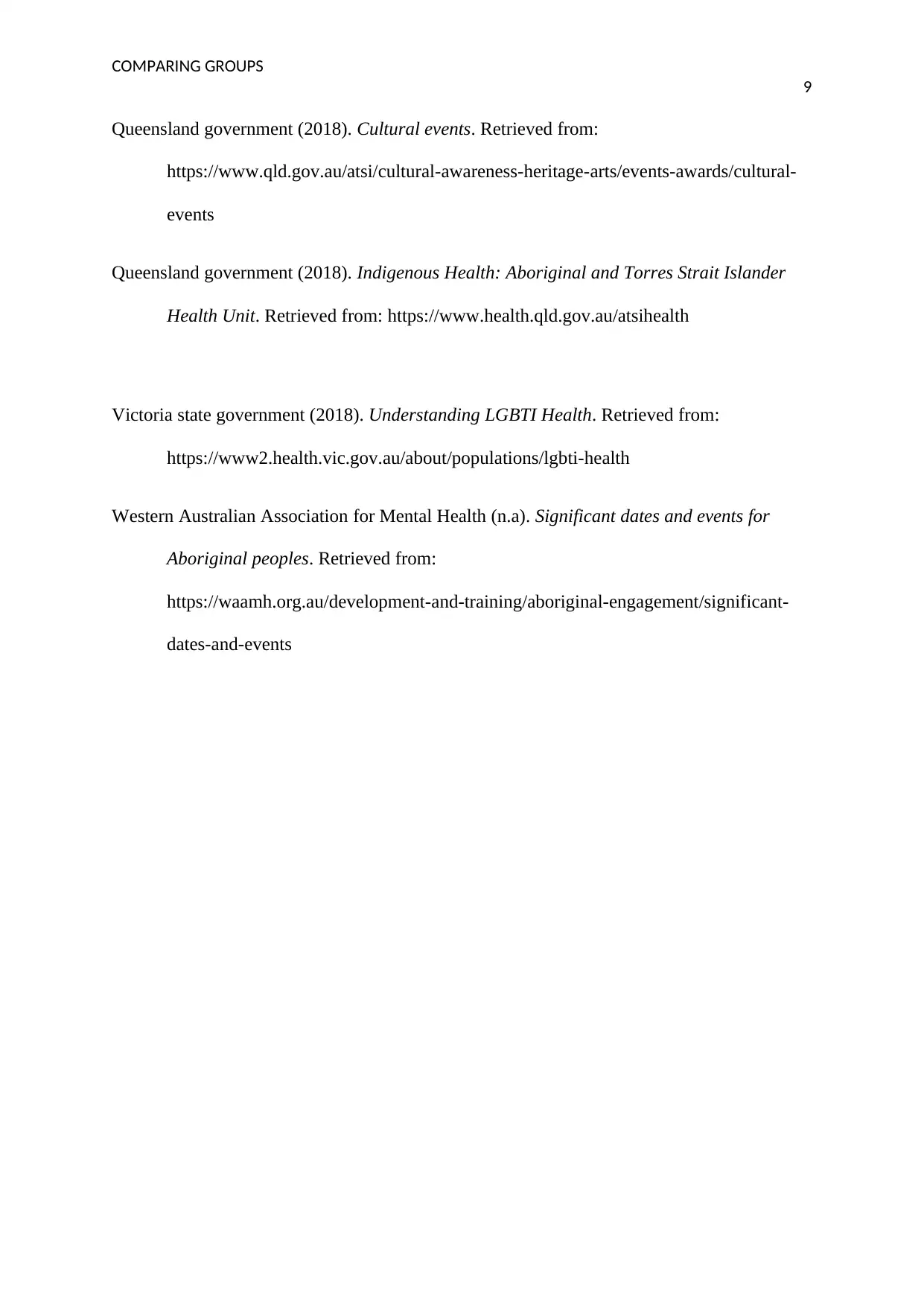
COMPARING GROUPS
9
Queensland government (2018). Cultural events. Retrieved from:
https://www.qld.gov.au/atsi/cultural-awareness-heritage-arts/events-awards/cultural-
events
Queensland government (2018). Indigenous Health: Aboriginal and Torres Strait Islander
Health Unit. Retrieved from: https://www.health.qld.gov.au/atsihealth
Victoria state government (2018). Understanding LGBTI Health. Retrieved from:
https://www2.health.vic.gov.au/about/populations/lgbti-health
Western Australian Association for Mental Health (n.a). Significant dates and events for
Aboriginal peoples. Retrieved from:
https://waamh.org.au/development-and-training/aboriginal-engagement/significant-
dates-and-events
9
Queensland government (2018). Cultural events. Retrieved from:
https://www.qld.gov.au/atsi/cultural-awareness-heritage-arts/events-awards/cultural-
events
Queensland government (2018). Indigenous Health: Aboriginal and Torres Strait Islander
Health Unit. Retrieved from: https://www.health.qld.gov.au/atsihealth
Victoria state government (2018). Understanding LGBTI Health. Retrieved from:
https://www2.health.vic.gov.au/about/populations/lgbti-health
Western Australian Association for Mental Health (n.a). Significant dates and events for
Aboriginal peoples. Retrieved from:
https://waamh.org.au/development-and-training/aboriginal-engagement/significant-
dates-and-events
1 out of 10
Related Documents
Your All-in-One AI-Powered Toolkit for Academic Success.
+13062052269
info@desklib.com
Available 24*7 on WhatsApp / Email
![[object Object]](/_next/static/media/star-bottom.7253800d.svg)
Unlock your academic potential
© 2024 | Zucol Services PVT LTD | All rights reserved.





